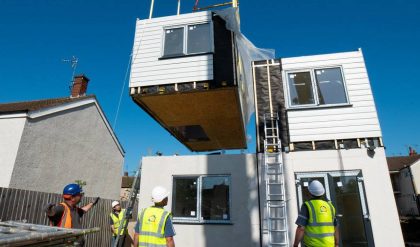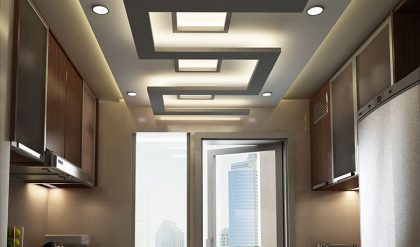Floors in buildings provide strong level surface to support occupants, furnitures, and other equipments. There are various functional requirements of floors which are discussed in this article.
Functional Requirements of Floors in Building Construction
Following are the functional requirements of floors in building:
- Strength and stability
- Resistance to weather and ground moisture
- Durability and free from maintenance
- Fire resistance
- Resistance to passage of heat
- Resistance to passage of sound

Strength and Stability of Floors in Buildings
Floor strength depends on the properties of material such as timber, reinforce concrete, and steel that are employed to construct the structure of the floor. The strength of floor structure should be adequate to carry dead load of the floor, finishes, fixtures, partitions, services and expected imposed loads of occupants.
Design loads for building can be found in both Minimum design loads for buildings and other structures (ASCE/SEI 7-10) and BS 6399: Part 1 in addition to other codes.
Reinforced concrete floor, which might be used for providing strength and fire resistance, will be suitable option to employ for cases where spans are long and imposed loads are large whereas timber floors for domestic buildings might be adequate.
With regard to stability of floors, the stiffness of floor should be enough to make the floor stay stable and level under its self weight and expected dead and live loads. Furthermore, the floors need to support and accommodate ventilation, water, electrical, heating services without causing detrimental effect on the stability of the floor.
The deflection of the floor must be adequately restricted and kept small to prevent cracking of rigid finishing.
Finally, Basement and solid ground floors stability are based on properties of concrete under them. For small domestic building concrete without reinforcement might be enough but for large loads like heavy equipment or machinery reinforced concrete slab is needed.
Additionally, suspension reinforced concrete slabs are necessary on shrinkable soil against soil differential contraction of expansion, specifically in situations where deep rooted trees are close to the site.

Resistance of Floors to Weather and Ground Moisture
Building ground floor specifically heated building is likely to encourage rising the moisture below the ground and make the floor wet slightly which feels cold and dissatisfying. Therefore, more heating may be required to create desired comfortable condition.
There are various factors which affect the moisture penetration level from the ground to the floor includes the nature of subsoil, water table, and whether the site is horizontal or sloping.
There is small amount of moisture penetration into the ground if the base is gravel or coarse grain sand because water table level is below the surface during the whole year; in this case, concrete slab is suitable solution to resist moisture penetration.
However, on a clay base, an appreciable amount of moisture will penetrate from the ground to the floor because water table is near to the surface. The latter can be tackled by concrete slab plus water-tight membrane which can be place under, on, or in the slab.

Durability of Floors and Free from Maintenance
Generally, water tight ground floors on solid base and suspended floors secured by walls and roof must be durable for the life of the structure and require slight maintenance, repair or improvement.
The durability and free from maintenance of floors are rely on the nature of materials applied and the wear they are exposed to.

Fire Resistance of Floors
Floors should withstand fire for enough period during which the occupant can get out of the building.
ACI 216.1-7 (Code Requirements for Determining Fire Resistance of Concrete and Masonry Construction Assemblies) determines rating of fire resistance that begin from an hour to 4 hours which based on the types of aggregate and the thickness of concrete cover.
Lastly, reinforced concrete floors combat fire for longer period compare with timber floors.
Resistance to Passage of Heat
Floors have to withstand heat release in situation that there are large air temperature differences on both opposite sides of the floor. For instance where an open port car is formed under buildings and the floors over the port is subjected to outside weather, so it has to be insulated.
Ground floor can be constructed in a way that prevents heat transfer from the floor to the ground or from ground to the floor by applying hardcore and a damp-proof membrane.
The damp-proof membrane, which can be placed on, under, or sandwiched in the concrete under the floor, will avoid floor damping and cold feeling. This will lead to decline heat that is necessary to make comfortable condition and decrease transfer of heat.
If under floor heating is employed, it is fundamental to apply a layer of heat insulation around the edge and below the floor slab to reduce heat transfer to the ground.
Resistance to Passage of Sound
It is considerably significant that upper floors, which separate dwellings, work as barrier and prevent transmission of sound.
Reinforced concrete floor work better in preventing transmission of airborne sound compare to low mass timber floor. That is why reinforced concrete floor can be effectively used to separate residents.
Moreover, lightweight insulating material or dense material can be used for filling the spaces between timber joists to enhance sound resistance of timber floors.
It is worth mentioning that using reinforced concrete floor with reasonable increase in cost will be more effective compare to timber floors which requires extra cost to reduce sound transmission by filling spaces between joists.
However, if the floor of existing buildings is timber then, filling joists of the timber with lightweight or dense material is the only solution to enhance sound insulation.
Impact sounds can be decline considerably and effectively by applying floor covering, for example, carpet or a resilient sheet under the surface of the floor. The resilient layer will diminish the sound of footstep in either a reinforced concrete floor or a timber floor.
Furthermore, the sound mitigation used for the timber and reinforced concrete floors do not tackle airborne sound which will be reflected and might amplify to a level that is not tolerable. The sound absorption of ceiling could be improved by choosing an absorbent acoustic tile or panel finishes.






Comments are closed.